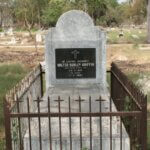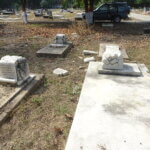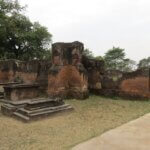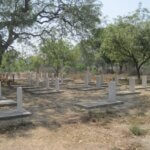Lucknow Cemeteries
This is the second in a series of posts by Prof Peter Stanley, the distinguished Australian military historian, who recently visited several historical sites in India gathering material for his forthcoming book (John Company’s Armies: the Military Forces of British India 1824-57).
This post covers places Peter visited in Lucknow. A post about his visit to the Mussoorie and Landour area was published on 18/1/24. Future posts will cover Peter’s visits to Kolkata and Barrackpore, Gwalior and Jhansi, and Agra.
In Lucknow, which I had not visited since 1986, I wanted to see the Residency again, of course, the scene of the siege and relief which formed one of the epics of the 1857-58 Mutiny-Rebellion, and also visit the Nishat Ganj Cemetery (formerly the Civil Lines Cemetery).
Nishat Ganj Cemetery (formerly the Civil Lines Cemetery)

(Photo: FIBIS)
Nishat Ganj Cemetery, the old Civil Lines Cemetery, is used by Lucknow’s Christian community and includes Christian graves from the mid-nineteenth century. I especially sought the grave of the American architect Walter Burley Griffin, designer of Canberra, who died in Lucknow in 1937.
(Note: Walter Burley Griffin, who was born in Chicago in 1876, and died in Lucknow, in 1937, was the subject of a short article in Chowkidar, Vol 5, No 1, published in Spring 1988 – Ed.)

Lines Cemetery at Lucknow
(Photo: P Stanley, 2023)
While in Lucknow I published a letter in the Canberra Times raising the idea of either caring for his grave more effectively, or even relocating it to Canberra.
I doubt that that idea will be taken up, but my letter might re-invigorate an intermittent discussion in Canberra over its founding visionary.
The most worrying feature to me was that many of the cemetery’s historical ‘British’ graves have been desecrated and vandalised, with almost all free-standing crosses especially smashed.
Lucknow Residency Burial Ground

(Photo: Iain MacFarlaine)
It is probably unnecessary for BACSA members versed in the history of British India to say much about the Residency itself, which through surviving buildings and some memorials evokes the drama of the siege. However, despite a small and well-presented museum (which has been renovated since my previous visit) little on the site explains what happened on the spot between July 1857 and the Residency’s evacuation in March 1858.
To make the connection between the place and the history you would be well-advised to bring along a good historical account. I had planned to bring Michael Edwardes’s A Season in Hell, but weight considerations left me with Christopher Hibbert’s excellent The Great Mutiny. Reading about the ordeal, even in the shade beside a cool, green lawn, helped me to imagine the battle the buildings had witnessed in 1857.
The reasonably well maintained Residency burial ground, mostly containing graves dated after 1857, was also evocative, except that several graves had been vandalised, with crosses especially having been destroyed. The absence of fragments suggests that this had occurred some time ago.
Lucknow Cantonment Military Cemetery

buried at Lucknow Cantonment
Cemetery
(Photo: CWGC)
I was particularly keen to see the graves of British soldiers buried at Lucknow, and was fortunate to meet a former member of the Indian Army’s Mechanised Infantry, who gave me a lift to the cantonment cemetery. This was a typical example of the serendipity that travellers in India can expect, and also a characteristic kindness of the sort I have often encountered.
Having published a book in 2019, ‘Terriers’ in India: British Territorials 1914-19, I was keen to see more of the graves of some of the thousand British Territorials who died in India during the Great War.
As expected, their graves were well maintained by the CWGC. The graves of, and memorials to, British soldiers who died in Lucknow other than in the Great War, however, are in various states. Some are accessible and legible, but others were overgrown and inaccessible. (Labourers were in the process of clearing the monsoon growth, cutting and burning undergrowth, but I don’t know how thorough they are: and it will grow back next year, as BACSA members well know.) Some large groups of graves seem to have been abandoned. I also saw graves which had been attacked, with crosses especially targeted.
For such a large cantonment (as Lucknow was) I was surprised at how few graves were in good condition. The visit brought home the magnitude of BACSA’s task.
Peter Stanley
